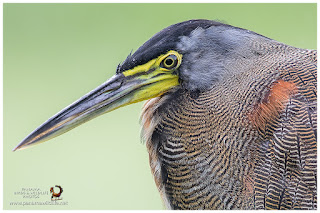 |
| Bare-throated Tiger Heron (Tigrisoma mexicanum) |
The
Bare-throated Tiger Heron (Tigrisoma mexicanum) is a wading bird of the
heron family found from Mexico to northwestern Colombia, with vagrant records from Texas, United States.
 |
| Bare-throated Tiger Heron (Tigrisoma mexicanum) |
 |
| Bare-throated Tiger Heron (Tigrisoma mexicanum) |
It is a large bird, measuring 80 cm (31 in) in length and weighing 1,200 g (42 oz), found often foraging in the open (differing from other Tigrisoma herons), such as river and lake banks, rice fields or farms, and beaches.
 |
| Bare-throated Tiger Heron (Tigrisoma mexicanum) |
It waits often motionless for suitable prey such as fish, frogs, crabs or small rodents to come within reach of its long spearlike black and yellow bill.
 |
| Bare-throated Tiger Heron (Tigrisoma mexicanum) |
The adult has black crown and light grey sides of head, the sides of the neck and the upperparts otherwise blackish narrowly barred buff. The median stripe down the fore-neck is rufous and white bordered with black; with rufous underpants.
 |
| Bare-throated Tiger Heron (Tigrisoma mexicanum) - juvenile |
Juveniles are strikingly barred black and rust throughout their bodies. A patch of bare skin on the throat, found on adults and juveniles, gives the species its common name.
 |
| Bare-throated Tiger Heron (Tigrisoma mexicanum) |
 |
| Bare-throated Tiger Heron (Tigrisoma mexicanum) |
This is a solitary breeder, not normally found in heron colonies. The nest is a small flattish stick platform in a tree into which 2–3 green-tinged white eggs are laid. In Panama it's common on Pacific islands including Coiba and Pearl Islands, and supposedly rare along mainland Pacific coast, but we usually find them in eastern Panamá Province.











NcoegeoOin_do1998 April Mitchell https://marketplace.visualstudio.com/items?itemName=frigitine.Descargar--necromancy-Emily-s-Escape-gratuita
ReplyDeletenopnaberoo
Yismemi-ta_Manchester Ryan Huot https://www.ramrojas.com/profile/cheyneyamabellcheyney/profile
ReplyDeletegarblanghallsi